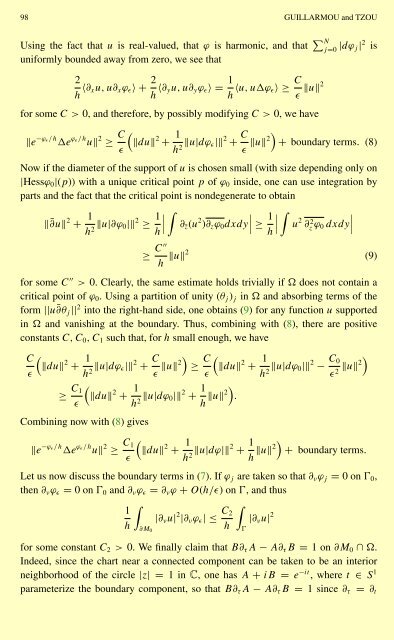NEAR OPTIMAL BOUNDS IN FREIMAN'S THEOREM
NEAR OPTIMAL BOUNDS IN FREIMAN'S THEOREM
NEAR OPTIMAL BOUNDS IN FREIMAN'S THEOREM
Create successful ePaper yourself
Turn your PDF publications into a flip-book with our unique Google optimized e-Paper software.
98 GUILLARMOU and TZOU<br />
Using the fact that u is real-valued, that ϕ is harmonic, and that N<br />
j=0 |dϕj| 2 is<br />
uniformly bounded away from zero, we see that<br />
2<br />
h 〈∂xu, u∂xϕɛ〉+ 2<br />
h 〈∂yu, u∂yϕɛ〉 = 1<br />
h 〈u, uϕɛ〉 ≥ C<br />
ɛ u2<br />
for some C>0, and therefore, by possibly modifying C>0, wehave<br />
e −ϕɛ/h ϕɛ/h 2 C<br />
<br />
e u ≥ du<br />
ɛ<br />
2 + 1<br />
h2 u|dϕɛ| 2 + C<br />
ɛ u2<br />
<br />
+ boundary terms. (8)<br />
Now if the diameter of the support of u is chosen small (with size depending only on<br />
|Hessϕ0|(p)) with a unique critical point p of ϕ0 inside, one can use integration by<br />
parts and the fact that the critical point is nondegenerate to obtain<br />
¯∂u 2 + 1<br />
h2 u|∂ϕ0| 2 ≥ 1<br />
<br />
<br />
∂¯z(u<br />
h<br />
2 <br />
<br />
)∂zϕ0dxdy<br />
≥ 1<br />
<br />
<br />
u<br />
h<br />
2 ∂2 z ϕ0<br />
<br />
<br />
dxdy<br />
≥ C′′<br />
h u2<br />
(9)<br />
for some C ′′ > 0. Clearly, the same estimate holds trivially if does not contain a<br />
critical point of ϕ0. Using a partition of unity (θj)j in and absorbing terms of the<br />
form ||u¯∂θj|| 2 into the right-hand side, one obtains (9) for any function u supported<br />
in and vanishing at the boundary. Thus, combining with (8), there are positive<br />
constants C, C0,C1 such that, for h small enough, we have<br />
C<br />
<br />
du<br />
ɛ<br />
2 + 1<br />
≥ C1<br />
ɛ<br />
h 2 u|dϕɛ| 2 + C<br />
ɛ u2<br />
<br />
<br />
du 2 + 1<br />
h 2 u|dϕ0| 2 + 1<br />
h u2<br />
Combining now with (8)gives<br />
≥ C<br />
<br />
du<br />
ɛ<br />
2 + 1<br />
<br />
.<br />
h2 u|dϕ0| 2 − C0<br />
ɛ<br />
<br />
u2<br />
2<br />
e −ϕɛ/h<br />
<br />
ϕɛ/h 2<br />
C1<br />
e u ≥ du<br />
ɛ<br />
2 + 1<br />
h2 u|dϕ|2 + 1<br />
h u2<br />
<br />
+ boundary terms.<br />
Let us now discuss the boundary terms in (7). If ϕj aretakensothat∂νϕj = 0 on Ɣ0,<br />
then ∂νϕɛ = 0 on Ɣ0 and ∂νϕɛ = ∂νϕ + O(h/ɛ) on Ɣ, and thus<br />
<br />
1<br />
|∂νu|<br />
h<br />
2 |∂νϕɛ| ≤ C2<br />
<br />
|∂νu|<br />
h<br />
2<br />
∂M0<br />
for some constant C2 > 0. We finally claim that B∂τ A − A∂τ B = 1 on ∂M0 ∩ .<br />
Indeed, since the chart near a connected component can be taken to be an interior<br />
neighborhood of the circle |z| =1 in C, one has A + iB = e −it , where t ∈ S 1<br />
parameterize the boundary component, so that B∂τ A − A∂τ B = 1 since ∂τ = ∂t<br />
Ɣ

















